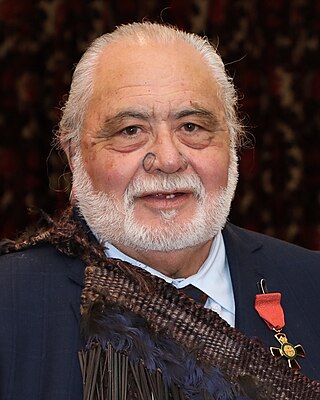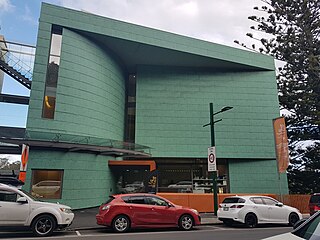Related Research Articles

Leonard Ramsay Castle was a New Zealand potter.
Shona Rapira Davies is a sculptor and painter of Ngātiwai ki Aotea tribal descent. Currently residing in Wellington New Zealand.
Humphrey John Ikin is a New Zealand furniture designer.
Ann Verdcourt was a New Zealand artist. She emigrated to New Zealand with her husband, ceramic artist John Lawrence, in 1965.
Ernest Shufflebotham was an English-born potter and designer active from the 1930s - 1950s.

Yuki Kihara is an interdisciplinary artist of Japanese and Samoan descent. In 2008, her work was the subject of a solo exhibition at the Metropolitan Museum of Art in New York; it was the first time a New Zealander and the first time a Pacific Islander had a solo show at the institution. Titled Shigeyuki Kihara: Living Photographs, the exhibition opened from 7 October 2008 to 1 February 2009. Kihara's self-portrait photographs in the exhibitions included nudes in poses that portrayed colonial images of Polynesian people as sexual objects. Her exhibition was followed by an acquisition of Kihara's work for the museum's collection.
Ian Barry Brickell was a New Zealand potter, writer, conservationist and founder of Driving Creek Railway.
Raewyn Atkinson is a New Zealand ceramicist. She completed a Diploma in Early Childhood Education at the Palmerston North Teachers College in 1975 and a Bachelor of Arts in Art History at Victoria University of Wellington in 1998.
Merilyn Wiseman was a New Zealand potter.

Wi Te Tau Pirika Taepa is a significant figure in contemporary New Zealand ceramics, and a leading figure in contemporary Māori clay art.
Chester Nealie is a New Zealand-born potter and teacher. In 1991 he moved to Australia.
Steve Fullmer is an American-born New Zealand potter.
Maria Louisa "Briar" Gardner was a New Zealand potter and speech therapist.
Richard John Parker is a New Zealand potter who has been based in Kaeo for most of his career.

Richard Steward Rudd is an English-born New Zealand potter.
Elizabeth McClure is a New Zealand based glass artist who was born in Lanark, Scotland.
Helen Hitchings was a New Zealand art dealer, best known for the short-lived but influential eponymous dealer gallery she opened in Wellington in 1949.
Gordon Stephen Crook was a visual artist working across the fields of ceramics, textiles, printmaking, painting and drawing.
Richard Stratton is a New Zealand ceramic artist.

Te Uru Waitākere Contemporary Gallery is a contemporary art gallery located in Titirangi, Auckland. The gallery, which serves the West Auckland region, was originally opened within Lopdell House in 1986.
References
- 1 2 3 4 "John Parker". The Arts Foundation of New Zealand. Archived from the original on 17 December 2014. Retrieved 16 December 2014.
- 1 2 3 4 5 6 Parker, John (2002). John Parker Ceramics. Wellington: City Gallery Wellington & David Bateman Ltd. ISBN 1869535154.
- ↑ "John Parker". Milford Galleries. Retrieved 16 December 2014.
- 1 2 3 4 5 Mansfield, Janet. Contemporary Ceramic Art in Australia and New Zealand. Rosefield East, NSW: Craftsman House. ISBN 9768097329.
- 1 2 3 Parker, John; Parkinson, Cecilia (1988). Profiles : 24 New Zealand potters. Auckland: David Bateman. p. 72. ISBN 0908610793.
- ↑ "John Parker: An eminent practitioner". Museum of New Zealand Te Papa Tongarewa. Retrieved 16 December 2014.
- ↑ Portage Ceramic Awards. Waitakere, Auckland: Lopdell House Gallery. 2013. p. 74. ISBN 9780987659798.
- ↑ Schamroth, Helen (1998). 100 New Zealand Craft Artists. Auckland: Random House. ISBN 1869620364.
- ↑ Daly-Peebles, John (12 March 2005). "Arts: From home and away at Auckland's AK05 festival". National Business Review. Retrieved 16 December 2014.
- ↑ "John Parker: Ceramics". City Gallery Wellington. Retrieved 16 December 2014.
- ↑ "John Parker: Cause and Effect". Te Uru. Retrieved 3 September 2016.
- ↑ "John Parker: Handmade Precision". Te Papa. Retrieved 3 December 2016.
- 1 2 "John Parker". Auckland Theatre Company. Retrieved 7 September 2021.
- ↑ "John Parker: Cause and Effect". Te Uru. Retrieved 14 September 2016.
- ↑ "John Parker". Avid Gallery. Retrieved 16 December 2014.